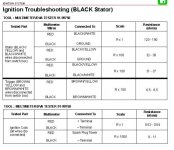Hello,
I'm working on a 1989 8 HP Mercury 2 Stroke that has no spark.
I haven't been able to find out what readings I'm looking for on the coil, stator, or trigger assembly for this motor. Keep in mind these reading are made while the parts are still on the motor. If I need to remove them to make the readings let me know.
Left Coil
Between Positive and Negative Terminals - 0.1 Ohm
Between Positive and Spark Plug Wire - 903 Ohms
Between Negative Spark Plug Wire - 904 Ohms
Right Coil
Between Positive and Negative Terminals - 0.1 Ohm
Between Positive and Spark Plug Wire - 972 Ohms
Between Negative Spark Plug Wire - 973 Ohms
Stator
Between the wires - 3.121k Ohms
Between blk/ylw and ground - 3.257 Ohms
Between blk/wht and ground - 135.7 Ohms
Trigger Assembly
Between the wires - 735
Between brwn/ylw and ground - Nothing
Between brwn/wht and ground - Nothing
Are these readings any good?
I read somewhere I could test the kill switches or kill switch wires, but the instructions were unclear. If anyone can guide me on how to work the wires in order to test the kill switches let me know.
I also read it could be the switch box, but there are zero instructions on how to test the switch box. Anyone know how to go about testing the switch box?
Also, is there anything else I can test for?
I'm working on a 1989 8 HP Mercury 2 Stroke that has no spark.
I haven't been able to find out what readings I'm looking for on the coil, stator, or trigger assembly for this motor. Keep in mind these reading are made while the parts are still on the motor. If I need to remove them to make the readings let me know.
Left Coil
Between Positive and Negative Terminals - 0.1 Ohm
Between Positive and Spark Plug Wire - 903 Ohms
Between Negative Spark Plug Wire - 904 Ohms
Right Coil
Between Positive and Negative Terminals - 0.1 Ohm
Between Positive and Spark Plug Wire - 972 Ohms
Between Negative Spark Plug Wire - 973 Ohms
Stator
Between the wires - 3.121k Ohms
Between blk/ylw and ground - 3.257 Ohms
Between blk/wht and ground - 135.7 Ohms
Trigger Assembly
Between the wires - 735
Between brwn/ylw and ground - Nothing
Between brwn/wht and ground - Nothing
Are these readings any good?
I read somewhere I could test the kill switches or kill switch wires, but the instructions were unclear. If anyone can guide me on how to work the wires in order to test the kill switches let me know.
I also read it could be the switch box, but there are zero instructions on how to test the switch box. Anyone know how to go about testing the switch box?
Also, is there anything else I can test for?


